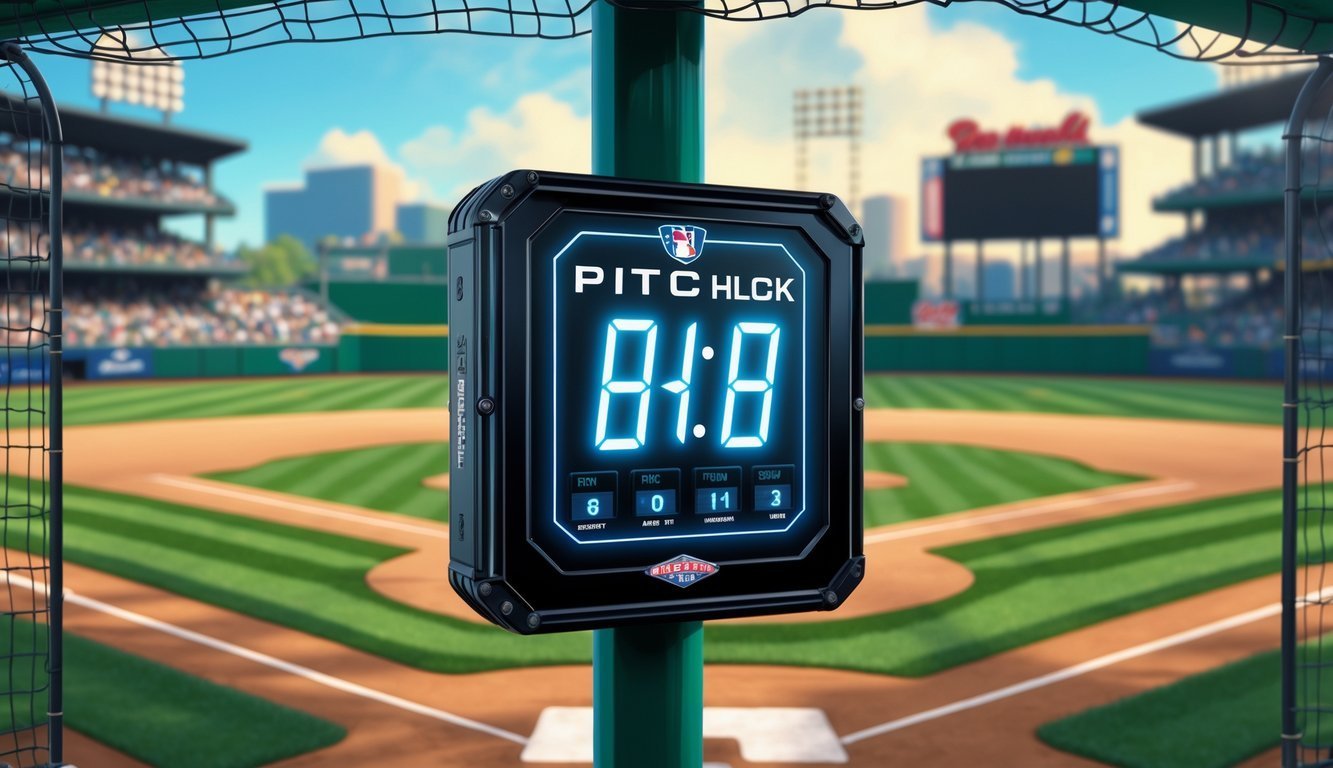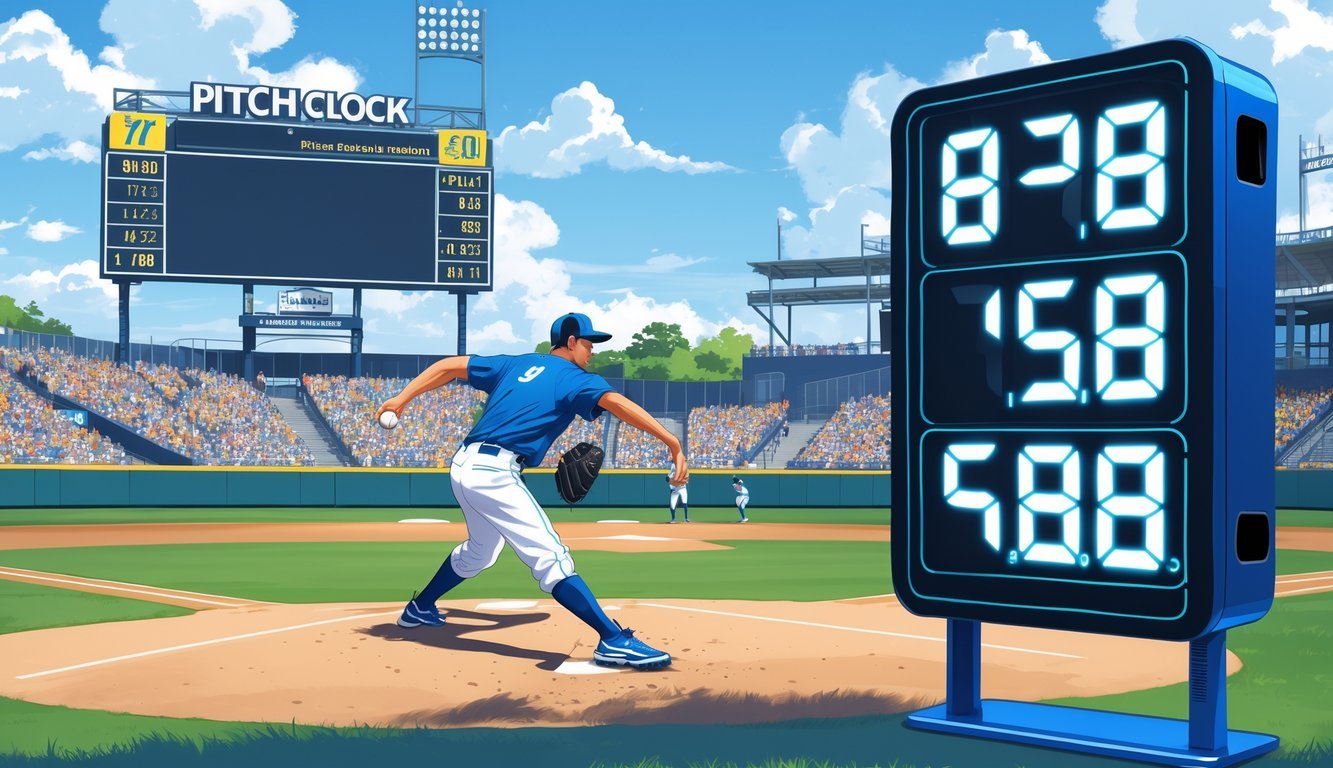Physical Address
304 North Cardinal St.
Dorchester Center, MA 02124
Physical Address
304 North Cardinal St.
Dorchester Center, MA 02124
The pitch clock enforces strict time limits for pitchers, enhancing game pace, reducing average game duration to 2 hours and 40 minutes, and improving fan engagement.

The baseball pitch clock is a new rule that pushes pitchers to throw faster by setting a limit on how long they can stand around between pitches.
Pitchers get just 15 to 20 seconds to deliver the ball, depending on whether there are runners on base. This rule keeps the pace brisk and, honestly, makes watching games a bit more exciting.
If you’ve ever sat through a game that felt like it would never end, you’ll probably appreciate the pitch clock.
By forcing both pitchers and batters to move things along, the game feels tighter and less bogged down by delays.
This shift changes not just how players approach their routines, but also how fans experience the action.
Understanding the pitch clock actually makes watching baseball more enjoyable.
You get why the pace is different, and it’s kind of refreshing to see a classic sport shake things up a bit.

The pitch clock keeps baseball moving by setting a clear timer for pitches.
Pitchers, batters, and umpires all have to pay attention to the countdown during every at-bat.
You’ll spot digital timers counting down between pitches and between batters, making sure no one lingers too long.
Major League Baseball (MLB) and some minor leagues use the pitch clock to limit how long a pitcher can take before throwing.
The main idea is to cut down on dead time and speed up games.
You’ll see a digital clock near the field with numbers ticking down, letting everyone know how much time is left.
Pitchers have to start their motion before time runs out.
Batters need to be in the box and alert before the clock hits eight seconds.
MLB brought in the pitch clock with other rule changes under Commissioner Rob Manfred.
It first showed up during spring training and now appears in regular games.
Pitchers have 15 seconds to throw if there’s nobody on base.
If runners are on, they get 20 seconds.
Between batters, pitchers have 30 seconds to get ready.
Batters must stand in the box, paying attention, by the time the clock shows eight seconds.
If they don’t, the umpire calls an automatic strike.
Umpires watch the timer closely to make sure everyone follows the timing rules.
The clock starts as soon as the pitcher gets the ball or after the last play ends.
Here’s how the timing shakes out:
| Situation | Time Allowed |
|---|---|
| Between batters | 30 seconds |
| Between pitches (no runners) | 15 seconds |
| Between pitches (runners on base) | 20 seconds |
Pitchers have to begin their motion before time runs out or they break the rule.
MLB also introduced bigger bases and a few other tweaks alongside the pitch clock to keep things moving and boost safety.
If a pitcher breaks the pitch clock rule, the umpire adds an automatic ball to the count.
If a batter isn’t ready in time, the umpire calls an automatic strike.
These penalties keep everyone on their toes.
Umpires don’t hesitate to enforce the rules, aiming for fairness and a steady pace.
If either side keeps breaking the rules, it can really shift the momentum of the game, rewarding players who stay sharp.

The pitch clock has changed how you watch and play baseball.
Games are shorter, players move with more urgency, and teams have had to rethink their strategies.
Games move faster now.
In 2023, the average MLB game dropped to about 2 hours and 40 minutes—down 24 minutes from before.
That’s finally under the three-hour mark, which fans and officials have wanted for years.
Pitchers must work quickly: 15 seconds with empty bases, 20 seconds with runners.
There’s only one timeout per plate appearance, so the endless pauses are gone.
Quicker games mean more action and less downtime.
Fans get a faster experience without missing the best parts.
Pitchers have had to adjust their routines, working with less time between throws.
Some people worry this might lead to more injuries, but so far, stats from 2023 don’t show a big increase.
Batters also need to be ready faster, which can throw off their timing.
Pickoff attempts have slowed, so runners sometimes get better chances to steal.
Teams like the Atlanta Braves and Boston Red Sox have changed how they position infielders and handle mound visits.
With fewer breaks, players have to make decisions on the fly.
Minor leagues tried out the pitch clock before the majors.
This gave everyone a chance to see if it would actually work.
Turns out, it did speed up games without making things feel rushed.
In the minors, umpires enforce the rules more strictly to get players used to the change.
Spring training games included the clock too, so everyone could practice at the new pace.
Teams like the New York Mets have used the new rules to train for quicker pitching and smarter base running.
Coaches at all levels now factor the pitch clock into their strategies, helping baseball stay modern while keeping its old-school charm.

Here’s what you might want to know about the MLB pitch clock, how it changes game length, and what happens if someone breaks the rules.
You’ll also get info about playoffs, when the clock started, and where to spot it in stadiums.
Pitchers have 15 seconds to throw if the bases are empty.
With runners on, they get 20 seconds.
Batters must be ready before the timer runs out.
There’s a 30-second timer between batters.
Games move faster now.
The pitch clock cuts down delays between pitches and batters, shaving several minutes off each game.
Yes.
If a pitcher runs out of time, the umpire adds a ball to the count.
If a batter isn’t ready, the umpire calls a strike.
These penalties keep everyone hustling.
Yes, the pitch clock stayed in place for the playoffs and the World Series.
MLB wanted the faster pace for all games, even the big ones.
MLB rolled out the pitch clock in 2023.
It was part of a bigger push to speed up games and make things more fun for fans.
You’ll usually spot the pitch clock near the outfield wall.
It’s right where players and fans can keep an eye on it.
Some stadiums put extra clocks near the dugouts.
Others might even have one behind home plate.